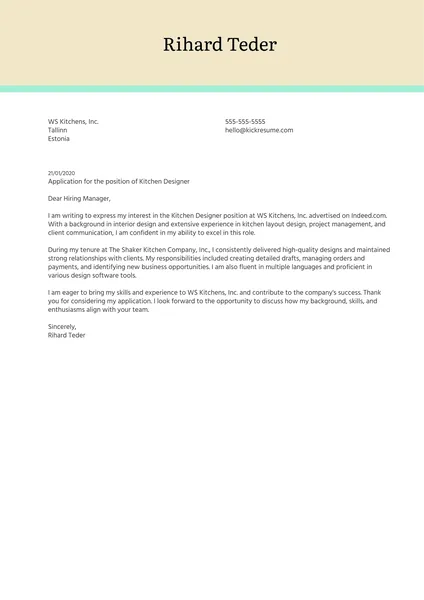A well-crafted interior designer cover letter is your first opportunity to make a lasting impression on a potential employer. It’s your chance to showcase not only your skills and experience but also your personality and passion for design. A strong cover letter can be the difference between landing an interview and having your application overlooked. This guide will provide you with actionable steps and expert advice on how to make your interior designer cover letter shine, ensuring you capture the attention of hiring managers and increase your chances of securing your dream job. From highlighting your unique skills to showcasing your design portfolio and tailoring your letter to the specific job requirements, you’ll gain valuable insights to create a compelling cover letter that sets you apart from the competition. Get ready to transform your job application and embark on a successful career in interior design.
Highlighting Your Interior Design Skills
The core of your cover letter should be a compelling presentation of your skills as an interior designer. It’s crucial to go beyond simply listing your abilities; instead, demonstrate how these skills align with the specific needs of the job and the company. Start by identifying the key skills mentioned in the job description and then craft concise, impactful statements that show how you’ve applied these skills in your previous projects. This might include proficiency in design software, such as AutoCAD, Revit, or SketchUp, as well as your knowledge of space planning, color theory, and material selection. More importantly, highlight your soft skills, such as communication, problem-solving, and the ability to work collaboratively, which are equally vital in the field of interior design. Remember to illustrate how you’ve successfully used these skills to deliver exceptional results for your clients.
Showcasing Your Design Portfolio
Your design portfolio is the visual centerpiece of your application and a crucial element of your cover letter. Your cover letter should act as a gateway to your portfolio, enticing the reader to explore your work. Briefly mention a few of your most impressive projects and the specific skills that are showcased in each. Mentioning details such as the project type, the client’s needs, and the successful outcomes demonstrates your ability to translate design concepts into tangible results. Make sure to include a direct link to your online portfolio or clearly explain how the recipient can view your work. Ensure your portfolio is easily accessible, well-organized, and displays a range of projects that reflect your versatility and creativity as an interior designer. It should feature high-quality images and detailed descriptions that effectively communicate your design vision and execution capabilities.
Tips for a Stunning Portfolio Presentation
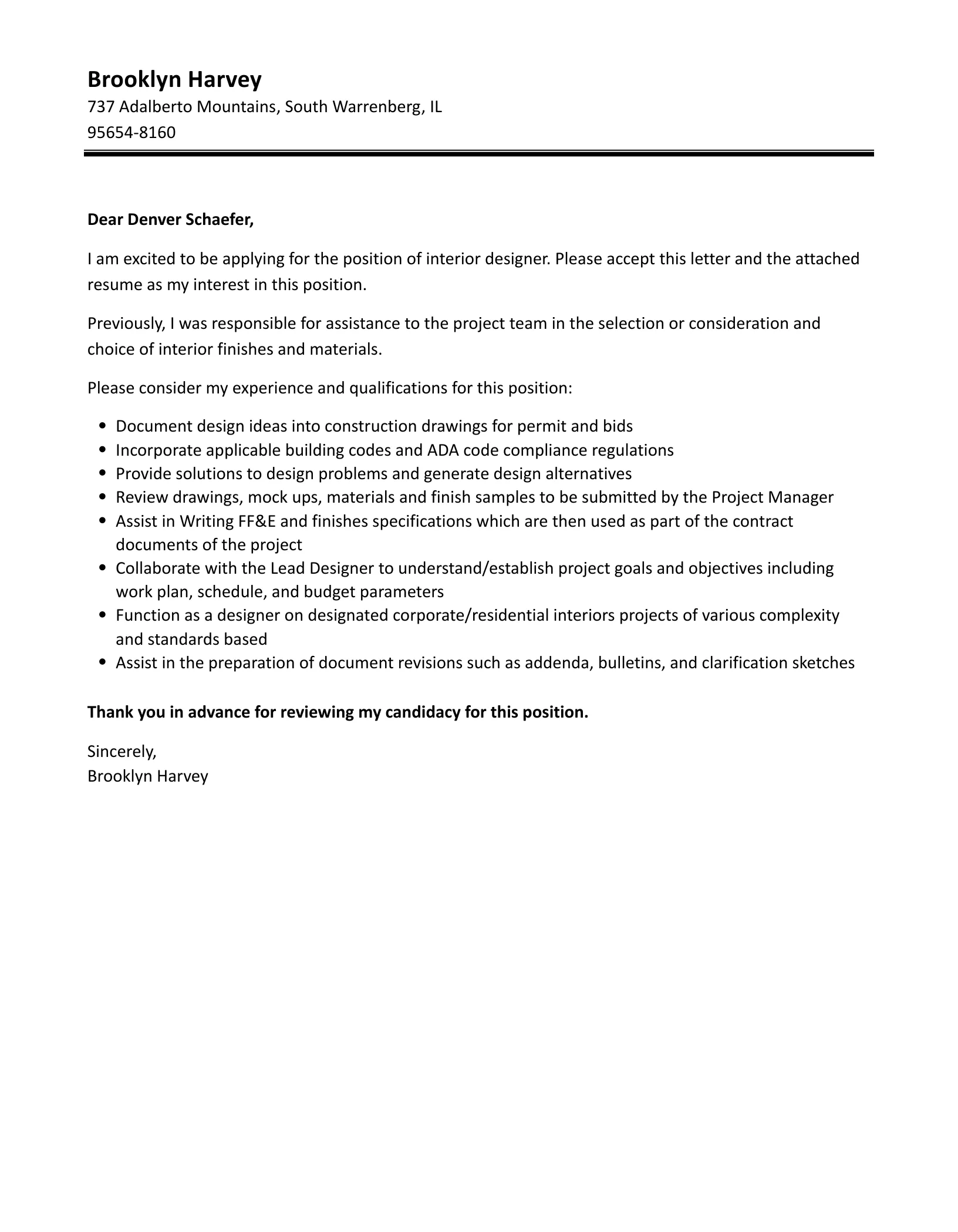
When presenting your portfolio, quality is key. Choose your best projects that highlight your skills and design aesthetic. Ensure your images are high-resolution and well-lit, showcasing the details of your designs. Provide concise descriptions for each project, explaining your design process, the challenges you faced, and the solutions you implemented. Organize your portfolio in a logical manner, perhaps by project type, design style, or the skills you want to emphasize. Consider including a brief introductory section that summarizes your design philosophy and approach. If you have a website, make sure it’s easy to navigate and mobile-friendly. Keep it updated with your latest work and relevant information, such as your contact details. This will make your portfolio a dynamic and engaging tool that captivates potential employers and highlights your expertise.
Tailoring Your Letter to the Job
One of the most effective ways to make your cover letter shine is to tailor it specifically to the job you are applying for. Generic cover letters are easily recognizable and often fail to impress. Research the company thoroughly and identify the specific skills, experience, and qualifications they are seeking. Then, customize your cover letter to address these requirements directly. Highlight the relevant aspects of your background and skills that align with the job description, and give examples of how you have successfully applied those skills in the past. Demonstrating your understanding of the company’s values, culture, and past projects shows that you’ve taken the time to learn about them and are genuinely interested in the opportunity.
Researching the Company and Its Values
Before you start writing your cover letter, take the time to research the company. Visit their website, check their social media profiles, and read any recent press releases or articles about them. Look for information about their design philosophy, the types of projects they work on, and their company culture. Identify the values that the company emphasizes, such as sustainability, innovation, or client satisfaction. By demonstrating your understanding of the company’s values, you can align your cover letter to resonate with them. For example, if the company is known for its sustainable design practices, highlight any experience you have with eco-friendly materials or green building certifications. This level of personalization shows that you’re genuinely interested in joining their team.
Emphasizing Relevant Experience
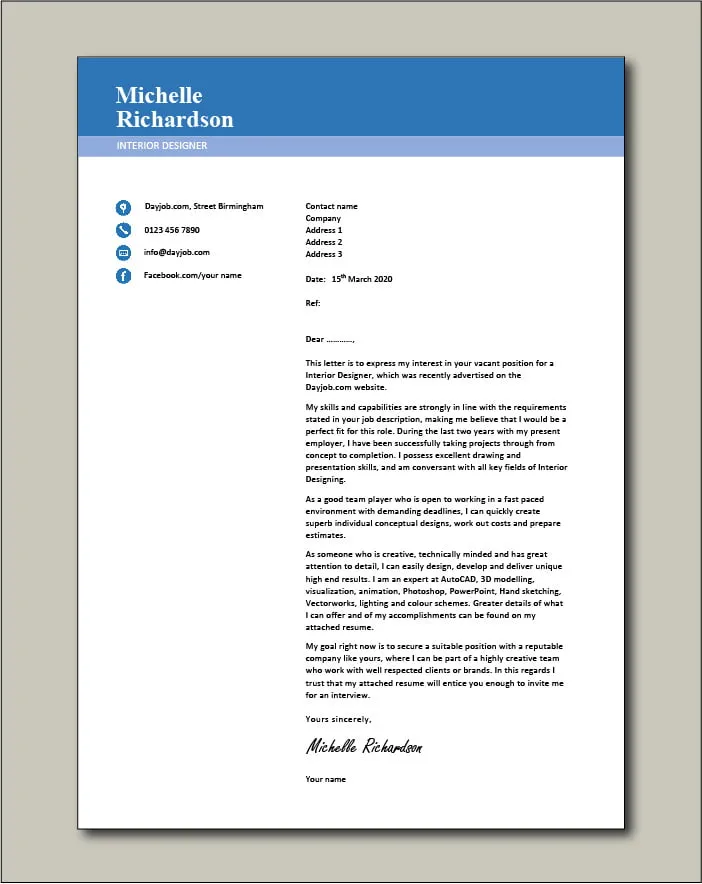
Clearly articulating your relevant experience is essential in making your cover letter stand out. Focus on the experience that is most closely aligned with the requirements of the job. If you have experience in residential design, and the job is for a residential firm, make this the focus of your letter. If you have experience in commercial design, emphasize that aspect of your background. When describing your past roles, be specific about your responsibilities, the projects you worked on, and the skills you utilized. Mention the size and scope of the projects, the types of clients you served, and the outcomes you achieved. Providing this kind of concrete detail helps the hiring manager quickly assess whether your experience matches the needs of the position. Focus on the quality of your experience rather than the quantity, choosing the most relevant and impressive examples.
Quantifying Your Achievements
To further strengthen your cover letter, quantify your achievements whenever possible. Instead of simply stating that you “improved client satisfaction,” provide metrics such as “increased client satisfaction scores by 20%” or “received positive feedback from 95% of clients.” Use numbers and data to demonstrate the tangible impact of your work. For example, if you managed projects, mention the number of projects you oversaw, the budgets you handled, or the deadlines you met. If you contributed to cost savings, state the specific amount or percentage saved. Quantifiable results give the hiring manager a clear understanding of your capabilities and the value you can bring to their company. They also provide concrete evidence that supports your claims about your skills and experience, making your cover letter more credible and compelling.
Using Action Verbs
Using strong action verbs is a critical element in making your cover letter dynamic and engaging. Action verbs describe the actions you took in your previous roles and highlight your accomplishments. Start your sentences with verbs that convey a sense of initiative, leadership, and results. Instead of saying “Responsible for,” use action verbs such as “Designed,” “Managed,” “Implemented,” “Collaborated,” “Created,” “Developed,” “Led,” or “Achieved.” For example, “Designed and executed a high-end residential project” is more compelling than “Was responsible for designing a residential project.” Action verbs make your cover letter more active and demonstrate your skills and capabilities. They also help the hiring manager quickly understand your responsibilities and the contributions you made in your previous roles.
Formatting and Professionalism
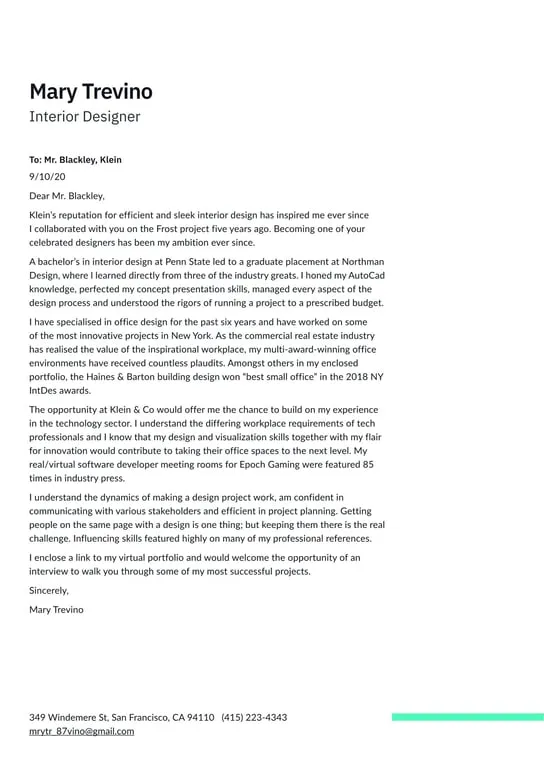
The format and overall professionalism of your cover letter are just as important as its content. A well-formatted letter shows attention to detail and demonstrates your ability to present information clearly. Use a professional font such as Arial, Calibri, or Times New Roman, with a font size between 10 and 12 points. Ensure your letter is easy to read by using clear headings, concise paragraphs, and adequate spacing. Avoid using jargon or overly complex language. Keep the tone of your letter professional, but also let your personality shine through. Proofread your cover letter carefully to eliminate any grammatical errors or typos, which can undermine your credibility. The goal is to present a polished and professional document that reflects your skills and experience.
Choosing the Right Font and Layout
Choosing the right font and layout is a crucial step in ensuring that your cover letter is visually appealing and easy to read. Select a clear and professional font such as Arial, Calibri, or Times New Roman. Avoid using fonts that are overly stylized or difficult to read. Keep the font size between 10 and 12 points for optimal readability. Use a standard letter format with a formal header, including your contact information and the date. Address the letter to the hiring manager by name, if possible. Use clear headings and subheadings to organize your content. Use ample white space to separate paragraphs and sections, making your letter visually appealing. Keep the layout consistent throughout the letter, using a consistent margin size, spacing, and text alignment. Your layout should facilitate a smooth reading experience, and highlight the most important parts of your letter.
Proofreading for Errors
Proofreading your cover letter is an essential step that should never be skipped. Errors in grammar, spelling, or punctuation can undermine your credibility and create a negative impression. Read your cover letter carefully, checking for any mistakes. It can be helpful to read your cover letter aloud, as this often reveals errors that you might miss when reading silently. Use a grammar and spell-checking tool, but don’t rely on it completely. Proofread multiple times, and consider asking a friend or family member to review your letter. They can provide a fresh perspective and catch errors that you might miss. Pay close attention to details, such as correct capitalization, punctuation, and sentence structure. Ensure that your contact information is accurate. A polished and error-free cover letter shows that you pay attention to detail and that you are committed to presenting yourself in the best possible light.
Making a Memorable Impression
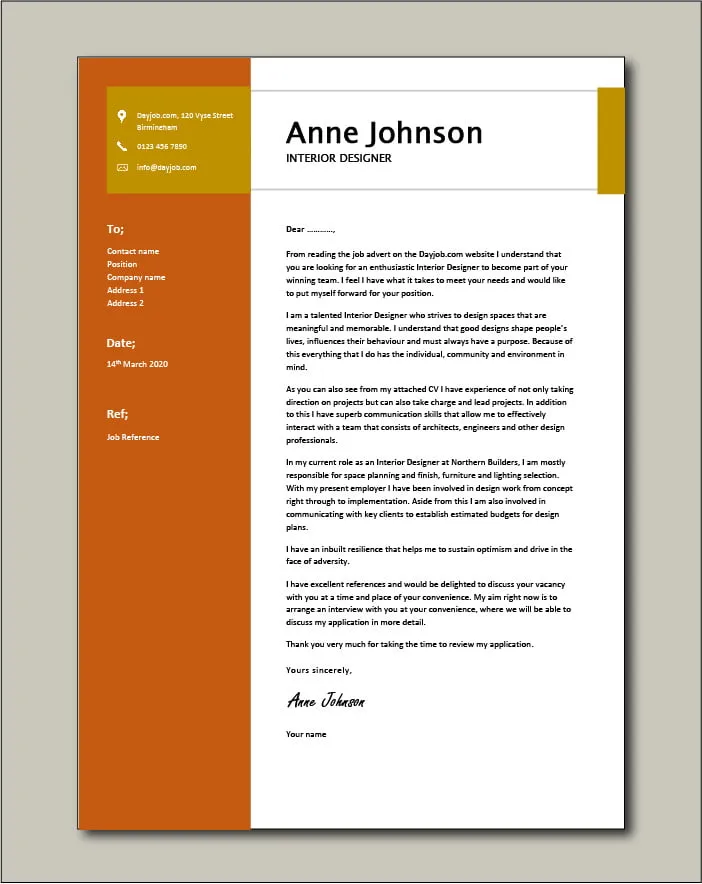
To make a lasting impression, your cover letter should go beyond simply listing your qualifications. It should showcase your personality, passion, and enthusiasm for interior design. Highlight any unique skills, experiences, or design approaches that differentiate you from other candidates. If you have a strong understanding of a particular design style or niche, such as sustainable design or historic preservation, mention it. Share your career goals and how the company aligns with your aspirations. Consider including a brief anecdote that illustrates your design philosophy or your ability to solve a particular challenge. The goal is to create a narrative that captivates the reader and makes them remember you. Your cover letter is your opportunity to showcase your individuality and your ability to contribute to their team and projects.
Expressing Enthusiasm and Follow-Up
End your cover letter with a strong closing that expresses your enthusiasm for the opportunity and your interest in an interview. Restate your interest in the position and reiterate why you are a good fit for the company. Thank the hiring manager for their time and consideration. Include a call to action, such as “I look forward to the opportunity to discuss my qualifications further.” Provide your contact information and make it easy for the hiring manager to reach you. State that you are available for an interview at their earliest convenience. Following up after submitting your application is also a good practice. Send a brief email a week or two after applying, reiterating your interest and asking if they need any further information. A thoughtful follow-up shows your dedication and professionalism, which can strengthen your chances of getting noticed.
In conclusion, crafting a compelling interior designer cover letter is a crucial step in your job search. By highlighting your skills, showcasing your portfolio, tailoring your letter, and demonstrating professionalism, you increase your chances of securing an interview and landing your dream job. Always proofread your letter and express your enthusiasm. With the right approach, your cover letter will shine and open doors to exciting opportunities in the world of interior design. Good luck.
